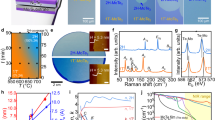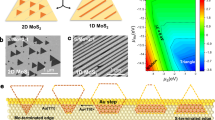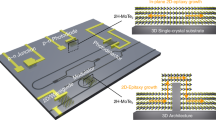Abstract
Crystal polymorphism selectively stabilizes the electronic phase of atomically thin transition-metal dichalcogenides (TMDCs) as metallic or semiconducting, suggesting the potential to integrate these polymorphs as circuit components in two-dimensional electronic circuitry. Developing a selective and sequential growth strategy for such two-dimensional polymorphs in the vapour phase is a critical step in this endeavour. Here, we report on the polymorphic integration of distinct metallic (1T′) and semiconducting (2H) MoTe2 crystals within the same atomic planes by heteroepitaxy. The realized polymorphic coplanar contact is atomically coherent, and its barrier potential is spatially tight-confined over a length of only a few nanometres, with a lowest contact barrier height of ∼25 meV. We also demonstrate the generality of our synthetic integration approach for other TMDC polymorph films with large areas.
This is a preview of subscription content, access via your institution
Access options
Access Nature and 54 other Nature Portfolio journals
Get Nature+, our best-value online-access subscription
$29.99 / 30 days
cancel any time
Subscribe to this journal
Receive 12 print issues and online access
$259.00 per year
only $21.58 per issue
Buy this article
- Purchase on Springer Link
- Instant access to full article PDF
Prices may be subject to local taxes which are calculated during checkout






Similar content being viewed by others
References
Chhowalla, M. et al. The chemistry of two-dimensional layered transition metal dichalcongenide nanosheet. Nat. Chem. 5, 263–275 (2013).
Lin, Y.-C., Dumcenco, D. O., Huang, Y.-S . & Suenaga, K. Atomic mechanism of the semiconducting-to-metallic phase transition in single-layered MoS2 . Nat. Nanotech. 9, 391–396 (2014).
Kappera, R. et al. Phase-engineered low-resistance contacts for ultrathin MoS2 transistors. Nat. Mater. 13, 1128–1134 (2014).
Cho, S. et al. Phase patterning for ohmic homojunction contact in MoTe2 . Science 349, 625–628 (2015).
Allain, A., Kang, J., Banerjee, K. & Kis, A. Electrical contacts two-dimensional semiconductor. Nat. Mater. 14, 1195–1205 (2015).
Fiori, G. et al. Electronics based on two-dimensional materials. Nat. Nanotech. 9, 768–779 (2014).
Wang, Q. H., Kalantar-Zadeh, K., Kis, A., Coleman, J. N. & Strano, M. S. Electronics and optoelectronics of two-dimensional transition metal dichalcogenides. Nat. Nanotech. 7, 699–712 (2012).
Levendorf, M. P. et al. Graphene and boron nitride lateral heterostructures for atomically thin circuitry. Nature 488, 627 (2012).
Liu, L. et al. Heteroepitaxial growth of two-dimensional hexagonal boron nitride template by graphene edge. Science 343, 163–167 (2014).
Huang, C. et al. Lateral heterojunction within monolayer MoSe2–WSe2 semiconductors. Nat. Mater. 13, 1096–1101 (2014).
Gong, Y. et al. Vertical and in-plane heterostructures from WS2/MoS2 monolayer. Nat. Mater. 13, 1135–1142 (2014).
Duan, X. et al. Lateral epitaxial growth of two-dimensional layered semiconductor heterojunctions. Nat. Nanotech. 9, 1024–1030 (2014).
Kang, K. et al. High-mobility three-atom-thick semiconducting films with wafer scale homogeneity. Nature 520, 656–660 (2015).
Heo, H. et al. Rotation-misfit-free heteroepitaxial stacking and stitching growth of hexagonal transition-metal dichalcogenide monolayers by nucleation kinetics controls. Adv. Mater. 27, 3803–3810 (2015).
Revolinsky, E. & Beerntsen, D. J. Electrical properties of α- and β-MoTe2 as affected by stoichiometry and preparation temperature. J. Phys. Chem. Solid 27, 523–526 (1966).
Vellinga, M. B., Jonge, R. de & Haas, C. Semiconductor to metal transition in MoTe2 . J. Solid State Chem. 2, 299–302 (1970).
Hughes, H. P. & Friend, R. H. Electrical resistivity anomaly in β-MoTe2 . J. Phys. C 11, L103–L105 (1978).
Albert, M., Kershaw, R., Dwight, K. & Wold, A. Preparation and characterization of semiconducting α-MoTe2 single crystals. Solid State Commun. 81, 649–651 (1992).
Keum, D. H. et al. Bandgap opening in few-layered monoclinic MoTe2 . Nat. Phys. 11, 482–487 (2015).
Park, J. C. et al. Phase-engineered synthesis of centimeter-scale 1Tʹ- and 2H-molybdenum ditelluride thin films. ACS Nano 9, 6548–6554 (2015).
Zhou, L. et al. Large-area synthesis of high-quality uniform few-layer MoTe2 . J. Am. Chem. Soc. 137, 11892–11895 (2015).
Naylor, C. H. et al. Monolayer single-crystal 1T′-MoTe2 grown by chemical vapour deposition exhibits a weak antilocalization effect. Nano Lett. 16, 4297–4304 (2016).
Ruppert, C., Aslan, O. B. & Heinz, T. F. Optical properties and band gap of single- and few-layer MoTe2 crystals. Nano Lett. 14, 6231–6236 (2014).
Ahn, J.-H. et al. Deterministic two-dimensional polymorphism growth of hexagonal n-type SnS2 and orthorhombic p-type SnS crystals. Nano Lett. 15, 3703–3708 (2015).
Sung, J. H. et al. Atomic layer-by-layer thermoelectric conversion in topological insulator bismuth/antimony tellurides. Nano Lett. 14, 4030–4035 (2014).
Heo, H. et al. Interlayer orientation-dependent light absorption and emission in monolayer semiconductor stacks. Nat. Commun. 6, 7372 (2015).
Kan, M., Nam, H. G., Lee, Y. H. & Sun, Q. Phase stability and Raman vibration of molybdenum ditelluride (MoTe2) monolayer. Phys. Chem. Chem. Phys. 17, 14866–14871 (2015).
Brown, B. E. The crystal structures of WTe2 and high-temperature MoTe2 . Acta Crystallogr. 20, 268–274 (1966).
Eda, G. et al. Coherent atomic and electronic heterostructures of single-layer MoS2 . ACS Nano 7, 7311–7317 (2012).
Puotinen, D. & Newnham, R. E. The crystal structure of MoTe2 . Acta Crystallogr. 14, 691–692 (1961).
Hla, S. W., Marinković, V., Prodan, A. & Muševič, I. STM/AFM investigations of β-MoTe2, α-MoTe2 and WTe2 . Surf. Sci. 352, 105–111 (1996).
Saidi, A., Hasbach, A., Raberg, W. & Wandelt, K. Atomic force microscopy and scanning tunneling microscopy/spectroscopy investigations of molybdenum ditellurides. J. Vac. Sci. Technol. A 16, 951–955 (1998).
Grant, A. J., Griffiths, T. M., Pitt, G. D. & Yoffe, A. D. The electrical properties and the magnitude of the indirect gap in the semiconducting transition metal dichalcogenide layer crystals. J. Phys. C 8, L17 (1975).
Martin, J. et al. Observation of electron–hole puddles in graphene using a scanning single-electron transistor. Nat. Phys. 4, 144–148 (2008).
Zhang, Y., Brar, V. W., Girit, C., Zettl, A. & Crommie, M. F. Origin of spatial charge inhomogeneity in graphene. Nat. Phys. 5, 722–726 (2009).
Lu, C.-P., Li, G., Mao, J., Wang, L.-M. & Andrei, E.-Y. Bandgap, mid-gap states, and gating effects in MoS2 . Nano Lett. 14, 4628–4633 (2014).
Qiu, H. et al. Hopping transport through defect-induced localized states in molybdenum disulphide. Nat. Commun. 4, 2642 (2013).
Hong, J. et al. Exploring atomic defects in molybdenum disulphide monolayers. Nat. Commun. 6, 6293 (2015).
Wang, L. et al. One-dimensional electrical contact to a two-dimensional material. Science 342, 614–617 (2013).
Cui, X. et al. Multi-terminal transport measurements of MoS2 using a van der Waals heterostructures device platform. Nat. Nanotech. 10, 534–540 (2015).
Liu, Y., Stradins, P. & Wei, S.-H. Van der Waals metal–semiconductor junction: weak Fermi level pinning enables effective tuning of Schottky barrier. Sci. Adv. 2, e1600069 (2016).
Sanches, O. L., Lembke, D., Kayci, M., Radenovic, A. & Kis, A. Ultrasensitive photodetectors based on monolayer MoS2 . Nat. Nanotech. 8, 497–501 (2013).
Das, S., Chen, H.-Y., Penumatch, A. V. & Appenzeller, J. High performance multilayer MoS2 transistors with scandium contacts. Nano Lett. 13, 100–105 (2013).
Radisavlijevic, B. & Kis, A. Mobility engineering and a metal–insulator transition in monolayer MoS2 . Nat. Mater. 12, 815–820 (2013).
Lin, Y.-F. et al. Ambipolar MoTe2 transistors and their applications in logic circuits. Adv. Mater. 26, 3263–3269 (2014).
Fathipour, S. et al. Exfoliated multilayer MoTe2 field-effect transistors. Appl. Phys. Lett. 105, 192101 (2014).
Yu, H., Kutana, A. & Yakobson, B. I. Carrier delocalization in two-dimensional coplanar p–n junctions of graphene and metal dichalcogenides. Nano Lett. 16, 5032–5036 (2016).
Mueller, T., Xia, F., Freitag, M., Tsang, J. & Avouris, Ph. Role of contacts in graphene transistors: a scanning photocurrent study. Phys. Rev. B 79, 245430 (2009).
Kuhn, K. J. Considerations for ultimate CMOS scaling. IEEE Trans. Electron Devices 59, 1813–1828 (2012).
Zhou, J. et al. Large-area and high-quality 2D transition metal telluride. Adv. Mater. 29, 1603471 (2017).
Acknowledgements
This work was supported by the Institute for Basic Science (IBS), Korea, under project code IBS-R014-A1. J.S.K. was also supported by the NRF through the SRC Center for Topological Matter (grant no. 2011-0030046) and the Max Planck POSTECH/KOREA Research Initiative Program (grant no. 2011-0031558).
Author information
Authors and Affiliations
Contributions
M.-H.J. and H.H. conceived and designed the project. S.S., H.H. and C.-S.L. synthesized MoTe2 polymorphs and carried out the AFM and Raman scattering characterizations. J.H.S., Y.H.K., J.K., S.-Y.S. and D.-H.K. performed device fabrication and electrical characterization. H.R.N., H.K.K. and H.W.Y. performed STM measurements. K.S. and S.-Y.C. acquired STEM images and analysed the data. M.-H.J., J.S.K., T.-H.K., S.-Y.C., J.H.S. and H.H. co-wrote the paper. All the authors discussed the results and commented on the manuscript.
Corresponding author
Ethics declarations
Competing interests
The authors declare no competing financial interests.
Supplementary information
Supplementary information
Supplementary information (PDF 1552 kb)
Rights and permissions
About this article
Cite this article
Sung, J., Heo, H., Si, S. et al. Coplanar semiconductor–metal circuitry defined on few-layer MoTe2 via polymorphic heteroepitaxy. Nature Nanotech 12, 1064–1070 (2017). https://doi.org/10.1038/nnano.2017.161
Received:
Accepted:
Published:
Issue Date:
DOI: https://doi.org/10.1038/nnano.2017.161
This article is cited by
-
Phase-engineered synthesis of atomically thin te single crystals with high on-state currents
Nature Communications (2024)
-
Fabrication of p-type 2D single-crystalline transistor arrays with Fermi-level-tuned van der Waals semimetal electrodes
Nature Communications (2023)
-
Robust growth of two-dimensional metal dichalcogenides and their alloys by active chalcogen monomer supply
Nature Communications (2022)
-
Endoepitaxial growth of monolayer mosaic heterostructures
Nature Nanotechnology (2022)
-
Growth of bilayer MoTe2 single crystals with strong non-linear Hall effect
Nature Communications (2022)



